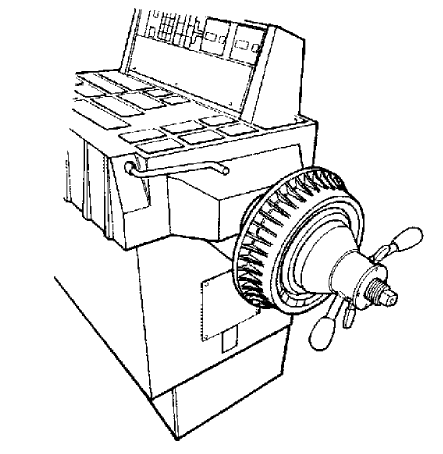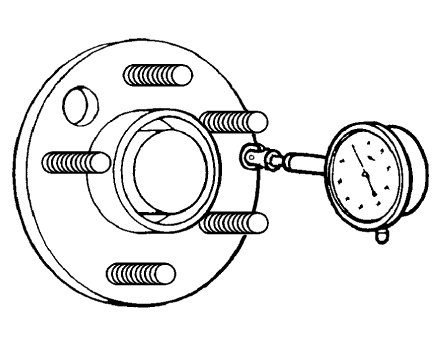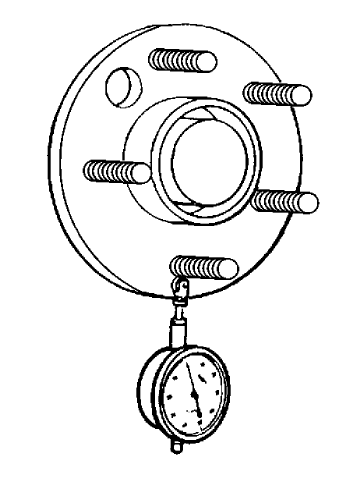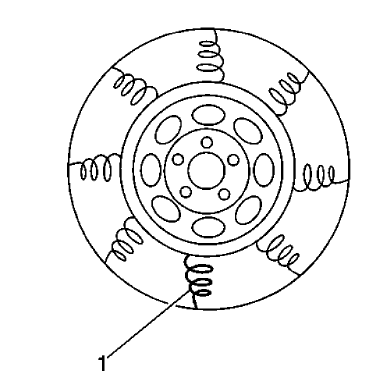Chevrolet Trax: Brake rotor/drum balance inspection
- Support the vehicle drive axle on a suitable hoist. Refer to Lifting and Jacking the Vehicle .
- Remove the tire and wheel assemblies from the drive axle. Refer to Tire and Wheel Removal and Installation .
- Reinstall the wheel nuts in order to retain the brake rotors.
- Run the vehicle at the concern speed while inspecting for the presence of the vibration.
CAUTION: Do not depress the brake pedal with the brake rotors and/or the brake drums removed, or with the brake calipers repositioned away from the brake rotors, or damage to the brake system may result.
- If the vibration is still present, remove the rotors from the drive axle, then run the vehicle back to the concern speed.
- If the vibration is eliminated when the brake rotors are removed from the drive axle, repeat the test with one rotor installed at a time. Replace the rotor that is causing or contributing to the vibration concern.

Fig. 12: Balancing Brake Drum
- If a brake rotor was replaced as a result of following the previous steps, or if necessary to confirm the results obtained during the previous steps, and/or to check the non-drive axle components, perform the following:
- Mount the brake rotor/drum on a balancer in the same manner as a tire and wheel assembly.
NOTE: Check brake rotors/drums for static imbalance only; ignore the dynamic imbalance readings.
- Inspect the rotor/drum for static imbalance.
There is not a set tolerance for brake rotor/drum static imbalance. However, any brake rotor/drum measured in this same manner which is over 21 g ( 3/4 oz) may have the potential to cause or contribute to a vibration.
Rotors/drums suspected of causing or contributing to a vibration should be replaced. Any rotor/drum that is replaced should be checked for imbalance in the same manner.
HUB/AXLE FLANGE AND WHEEL STUD RUNOUT INSPECTION
Special Tools
GE-8001 Dial Indicator Set
For equivalent regional tools, refer to Special Tools and Equipment.
- Raise and support the vehicle. Refer to Lifting and Jacking the Vehicle .
- Mark the location of the wheels to the wheel studs and mark the specific vehicle position on each tire and wheel - LF, LR, RF, RR.
- Remove the tire and wheel assemblies from the vehicle. Refer to Tire and Wheel Removal and Installation .
- Remove the brake rotors and/or brake drums from the vehicle. Clean the mounting surfaces of the brake rotors, the brake drums, if equipped, and the hub/axle flanges of any loose debris, rust, and corrosion.

Fig. 13: Measuring Wheel Hub/Axle Flange Runout
- Position the GE-8001 Dial Indicator Set , or equivalent, on the machined surface of the wheel hub/axle flange outside of the wheel studs.
- Rotate the hub one complete revolution in order to find the low spot.
- Set the GE-8001 Dial Indicator Set , or equivalent, to zero at the low spot.
- Rotate the hub one more complete revolution and measure the total amount of wheel hub/axle flange runout.
Specification
Wheel hub/axle flange runout tolerance guideline: 0.132 mm (0.005 in)
- If the runout of the wheel hub/axle flange IS within specification and the vehicle is equipped with wheel studs, proceed to step 13.
- If the runout of the wheel hub/axle flange IS within specification and the vehicle is equipped with wheel bolts, proceed to step 19.
- If the runout of the wheel hub/axle flange is marginal, the wheel hub may or may not be the source of the disturbance.
- If the runout of the wheel hub/axle flange is excessive, replace the wheel hub/axle flange. Measure the runout of the new wheel hub/axle flange.

Fig. 14: Measuring Wheel Stud Runout
- Position the GE-8001 Dial Indicator Set , or equivalent, in order to
contact the wheel mounting studs.
Measure the stud runout as close to the flange as possible.
- Turn the hub one complete revolution to register on each of the wheel studs.
- Zero the GE-8001 Dial Indicator Set , or equivalent, on the lowest stud.
- Rotate the hub one more complete revolution and measure the total amount of wheel stud - stud circle - runout.
Specification
Wheel stud runout tolerance guideline: 0.254 mm (0.010 in)
- If the runout of the wheel studs - stud circle - is marginal, the wheel studs may or may not be contributing to the disturbance.
- If the runout of the wheel studs - stud circle - is excessive, replace the wheel studs as necessary. Measure the runout of the new wheel studs.
- Inspect the threads and the tapered seat portion on each of the wheel bolts for damage.
- Wheel bolts exibiting damaged threads and/or damaged tapered seats require replacement.
- Place the threaded portion of each wheel bolt along a straight edge to inspect for straightness.
- Wheel bolts that are not straight require replacement.
TIRE AND WHEEL ASSEMBLY ISOLATION TEST
Force Variation
Force variation refers to a radial or lateral movement of the tire and wheel assembly which acts much like runout, however, force variation has to do with variations in the construction of the tire. These variations in tire construction may actually cause vibration in a vehicle, even though the tire and wheel assembly runout and balance may be within specifications.
Radial Force Variation

Fig. 15: Identifying Radial Force Variation
Radial force variation refers to the difference in the stiffness of a tire sidewall as the tire rotates and contacts the road. Tire sidewalls have some stiffness due to splices in the different plies of the tire, but these stiffness differences do not cause a problem unless the force variation is excessive. Stiff spots (1) in a tire sidewall can deflect a tire and wheel assembly upward as the assembly contacts the road.
Lateral Force Runout

Fig. 16: Identifying Tire Wobble/Waddle
Lateral force variation refers to the difference in the stiffness or conformity of the belts within a tire as the tire rotates and contacts the road. Tire belts may have some stiffness or conformity differences, but these differences do not cause a problem unless the force variation is excessive. These variations in the belts of the tire can deflect the vehicle sideways or laterally. A shifted belt inside a tire may cause lateral force variation.
In most cases where excessive lateral force variation exists, the vehicle will display a wobble or waddle at low speeds, 8-40 km/h (5-25 mph), on a smooth road surface.
Isolation Test Procedure
Perform the following test in order to determine if force variation is present in the vehicle.
- Substitute a set of KNOWN GOOD, pre-tested tire and wheel assemblies of the same size and type for the suspected original assemblies. Refer to Tire and Wheel Removal and Installation .
- Road test the vehicle to determine if the vibration is still present. Refer to Vibration Analysis - Road Testing (EL-38792-A Electronic Vibration Analyzer), Vibration Analysis - Road Testing (CH- 51450-NVH Oscilloscope).
- If the vibration is still present while using the known good set of tire and wheel assemblies, then force variation is not the cause of the vibration.
- If the vibration is eliminated when using the known good set of tire and
wheel assemblies, install one of
the original tire and wheel assemblies using the matchmarks made prior to
removal. Refer to Tire and
Wheel Removal and Installation , . Road test the vehicle to determine if the
vibration has returned.
Refer to Vibration Analysis - Road Testing (EL-38792-A Electronic Vibration Analyzer), Vibration Analysis - Road Testing (CH-51450-NVH Oscilloscope).
- Continue the process of installing the original tire and wheel assemblies one at a time, then road testing the vehicle, until the tire and wheel assembly, or assemblies which is causing the vibration has been identified.
- Replace the tire, or tires on the vibration-causing tire and wheel assembly, or assemblies, then balance the assembly, or assemblies. Refer to Tire and Wheel Assembly Runout Measurement - Off Vehicle.

